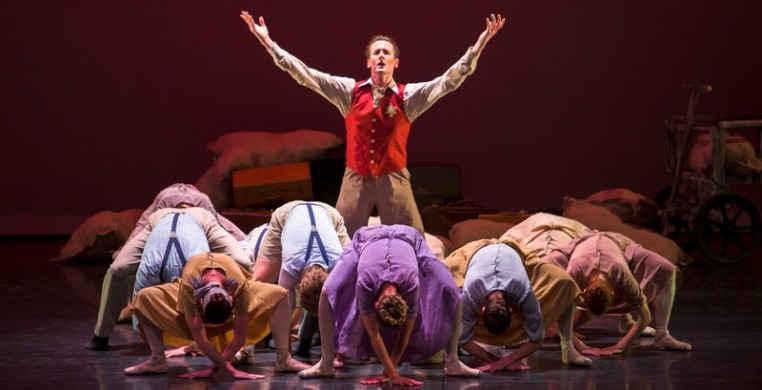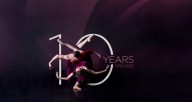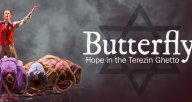I’ve said it before, and I will say it again. Ballet 5:8 is doing something different. Like a cocoon transforming into a butterfly, it is conveniently the name of their latest work. Ballet 5:8 is transforming the oftentimes stiff perceptions of ballet into a malleable clay that we can all touch, be touched by and play with.
As I sat in my seat on February 11th waiting for the opening number at the Logan Center for the Arts, a hotbed for the arts nestled on Chicago’s south side, I got a little excited. I suspected the afternoon would be a time of firsts, metamorphizing perceptions about Chicago’s South Side, ballet, and the horrors of the holocaust.
Full out, with an impressive ensemble of ten, we were invited into the sweeping technical phrases of the opening number and world premiere of “Wind,” choreographed by former Alvin Ailey Repertory Ensemble and Martha Graham Dance Company member Steve Rooks. In fluid gray dresses and pants, the dancers explored the winds of change through both carefully placed port de bras and magnetic momentum. A sprightly score by Alfonso Peduto gave flight to the company's wings.
The second half of the program, entitled “Butterfly,” is one of Ballet 5:8’s critically acclaimed classics, revived from the 2019 season, in-spirited by the diary of holocaust survivor Helga Weiss and the poem, “The Butterfly,” by Pavel Friedmann.
Organized by a chronological timeline of dates projected between the years of 1941-1944, “Butterfly” follows Holocaust survivor Helga Weiss' diary entries during those horrific years in the Terezin concentration camp. I felt like my eyes were playing tricks on me as an ensemble of six repeated a sequence of tendus in linear patterns. What appeared to be traditional Jewish scarves blended into a backdrop of endless news articles.
The moment of unison came to a halt as a militant quartet of Nazi Soldiers entered with their interruptions. Dressed in uniformed black attire, holding wide second positions, and threatening military stances, this juxtaposition between hope and fear repeated in an endless loop. As soon as we let down our guard with the tenderness of the vignette sequences danced by the Jewish Leaders or the Jewish Children, our oxygen was stripped by the urgent and somber sound of helicopters, war, radios, news, and the scent of death.
 Photo by Lana Kozol
Photo by Lana Kozol
As my eyes followed the pedestrian-style work gestures, coupled with larger-than-life arabesques in the “Arriving to Camp” scene, I returned to the quote in Weiss’s diary entry: “We feel-I can’t find the word, and maybe none exists that could express the sorrow of this moment. And yet Mom and I will stay together, while Dad will be alone. It must be a hundred times worse for him.” Although Weiss struggled to find the sentiments and language of her horrific experience, she managed to document the little that she had. Because of this, her story remains in orbit.
“Painting with Friedl” was a more hopeful butterfly scene. We entered an imaginary world of wands and Disney-esque music. Watercolor paintings were projected on the back scrim while we experienced light and whimsical turn sequences. Inspired by teaching artist Friedl-Dicker Brandeis, the paintings gave the children a sense of imagined freedom and joy through their artistic expression under impossible conditions. “Friedl’s teaching, the times spent drawing with her, are among the fondest memories of my life. Terezin made it more poignant but it would have been the same anywhere in the world… Friedl was the only one who taught without ever asking for anything in return. She just gave of herself.” -Elena Makarova.
Hopeful moments in the work continued to see clouds of impending doom as the Nazi Soldiers disturbed the sequences with their sharp arms, surprising moments on pointe, and a gun. A memorable element of surprise was when one of the Nazi Soldiers had what appeared to be a change of heart. Played by standout company member Natalie Chinn, she was able to impart a startling, softer side to the villains when she presented the Jewish leaders and children with a scarlet rose.
Shining as a triple threat with “Butterfly,” Ballet 5:8 Artistic Director and Resident Choreographer Julianna Rubio Slager was operating in all her gifts serving as Choreographer, Lighting Designer and Conceptual Designer of the work. As a Mexican American woman, Rubio Slager brings a vision of her own to her repertoire of ballets, whether it’s amplifying the voice of those that have been othered in Greek mythology, advocating for environmentally friendly set and costume design, or being vocal about the company's mission to keep god at the forefront of their endeavors. Like the life cycle of the butterfly, Rubio Slager and her long-standing women-led team are aligned and committed to actualizing change in their labors of love and in society.



